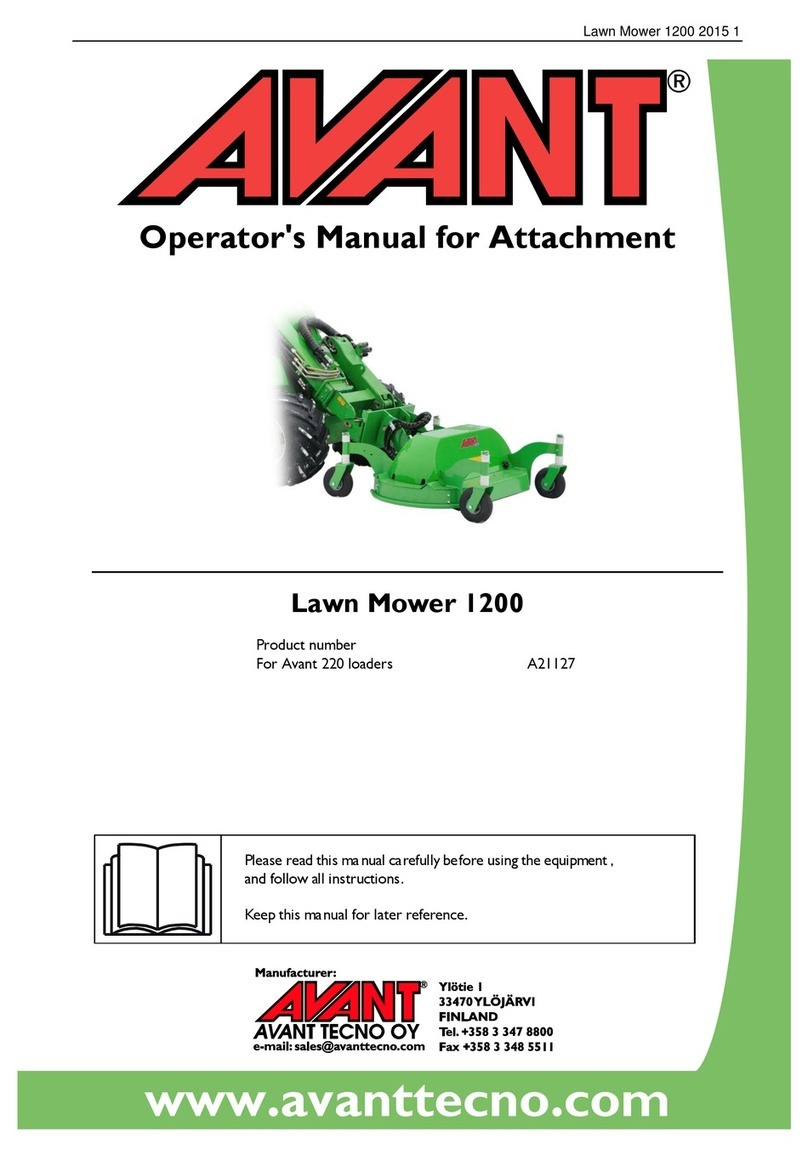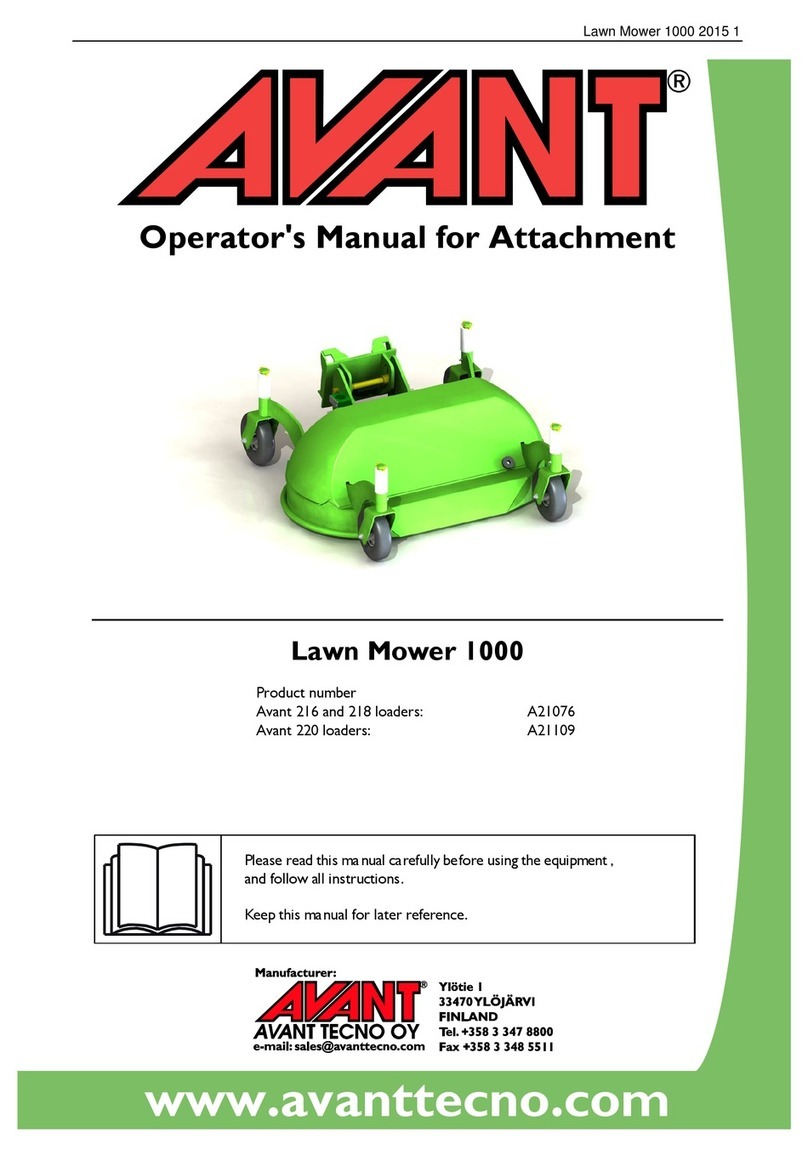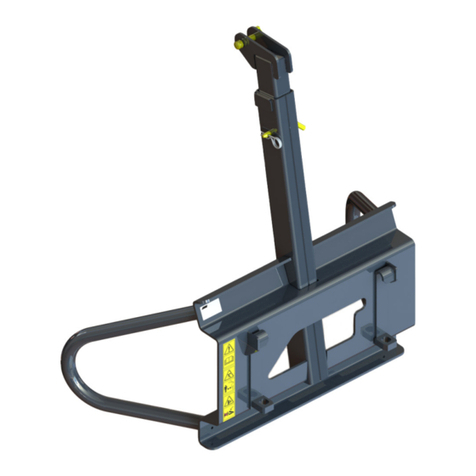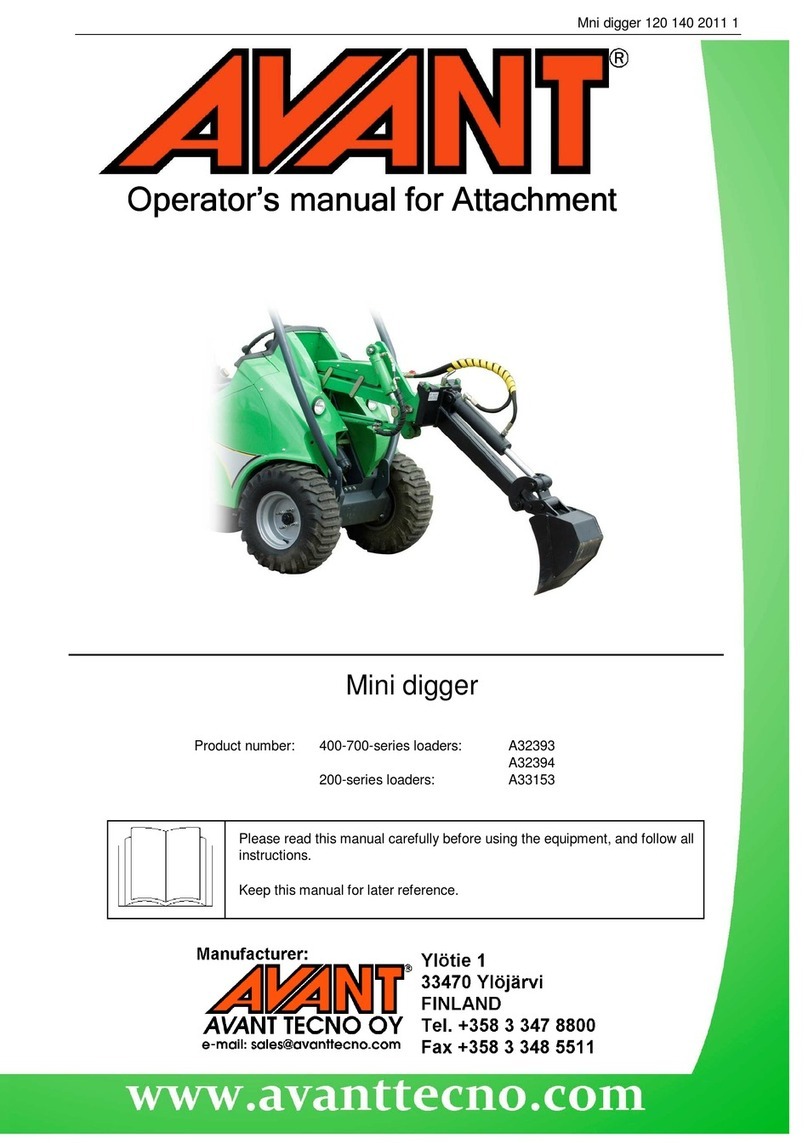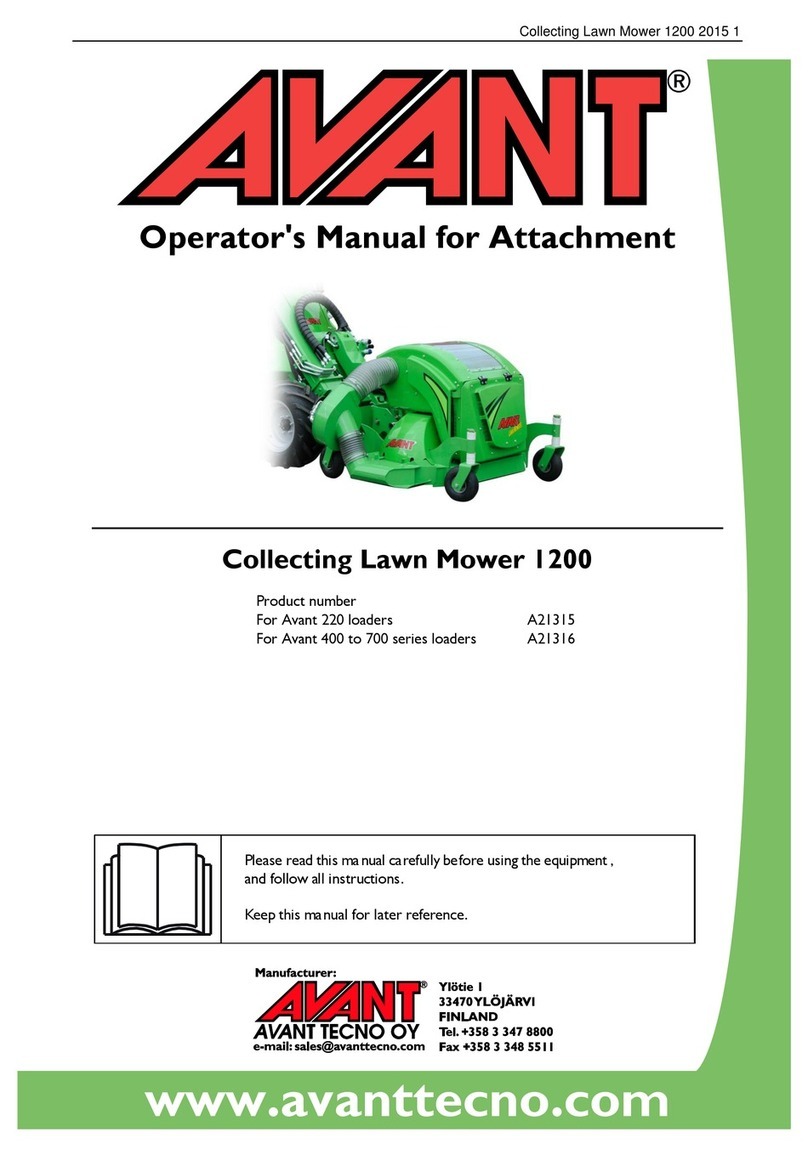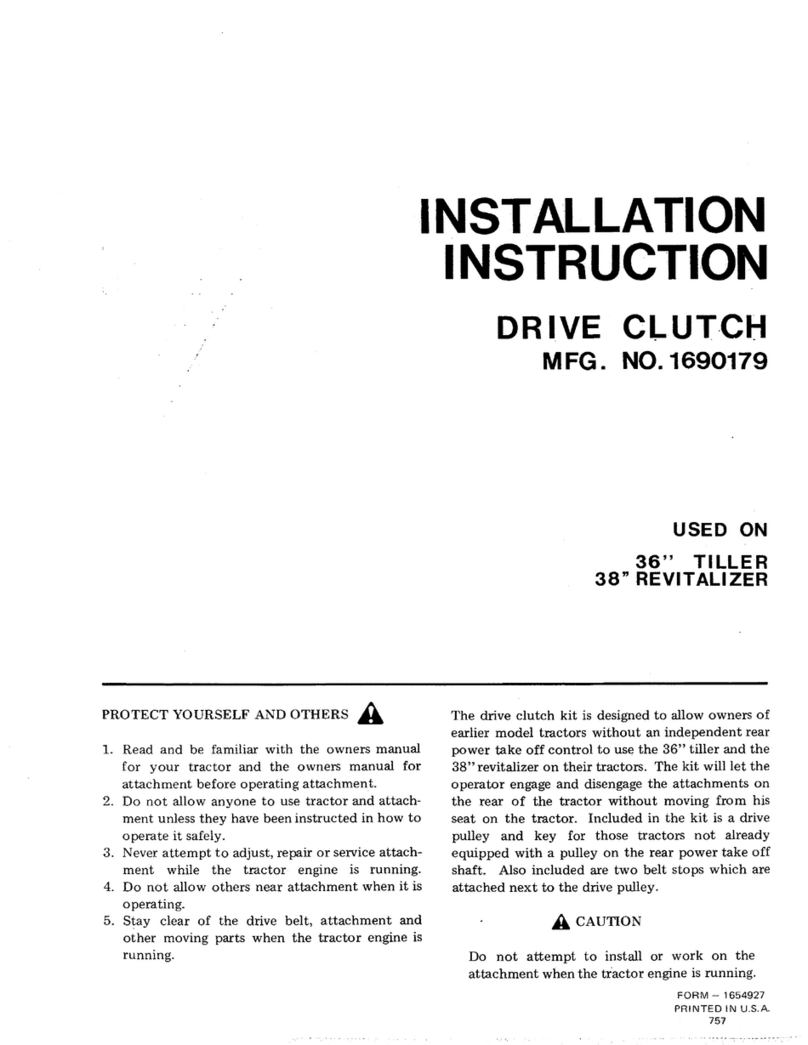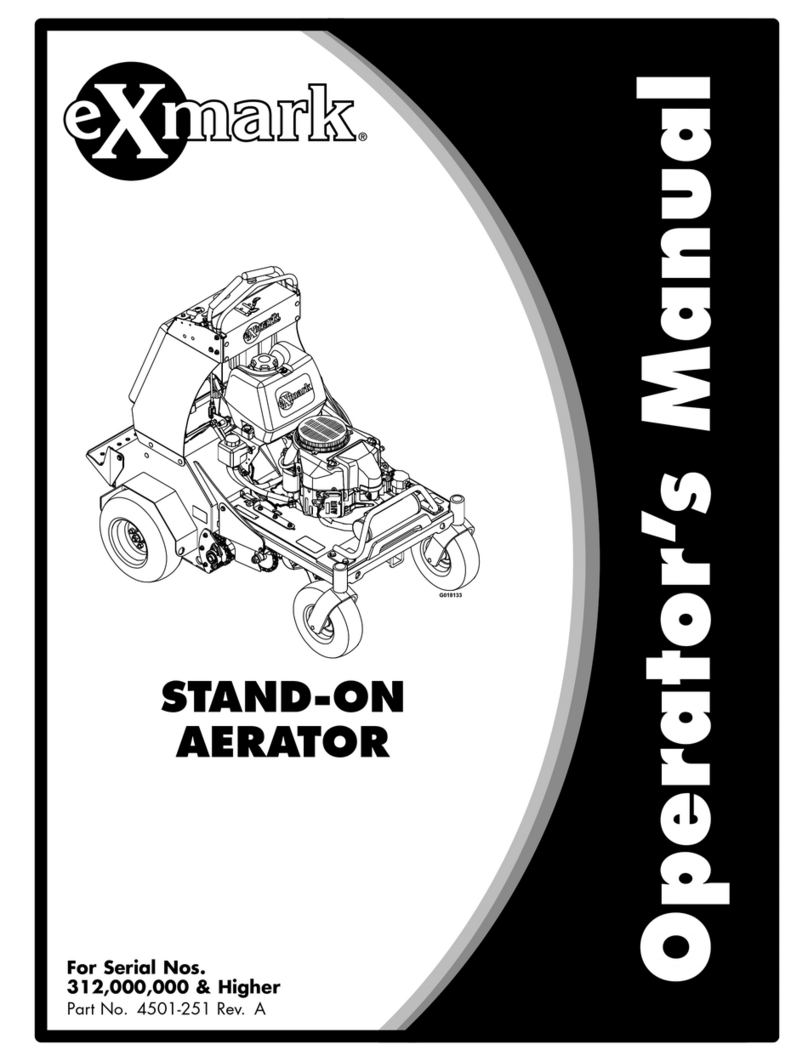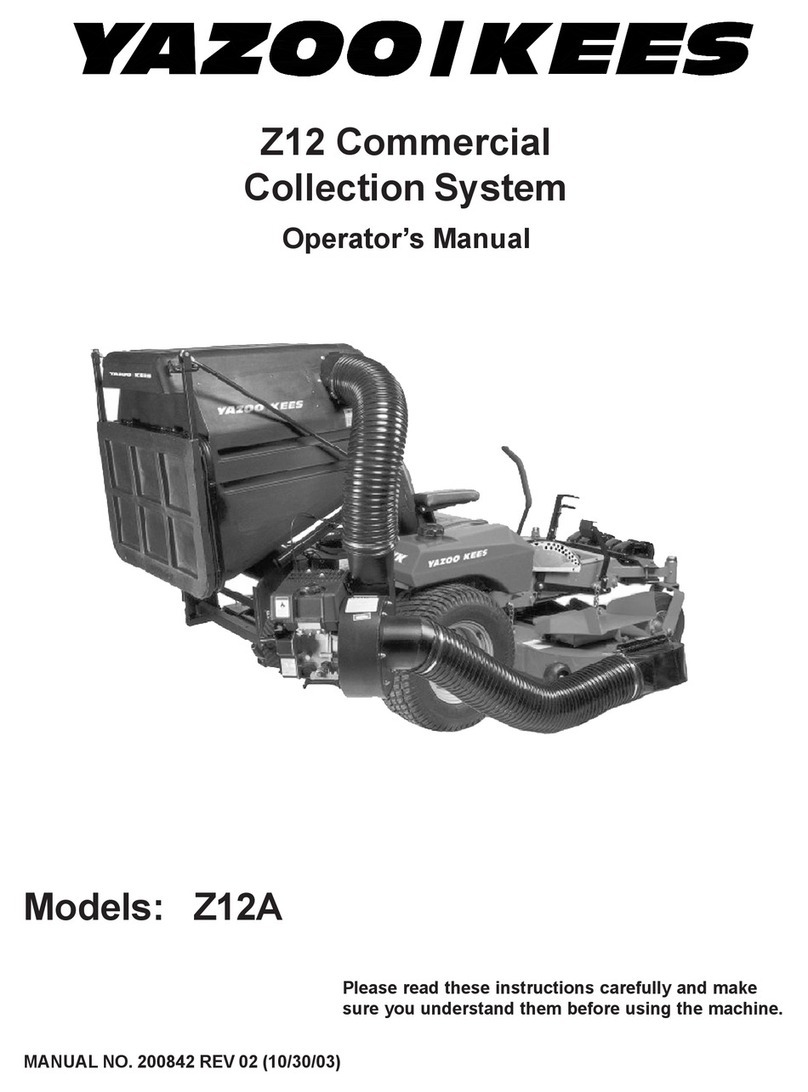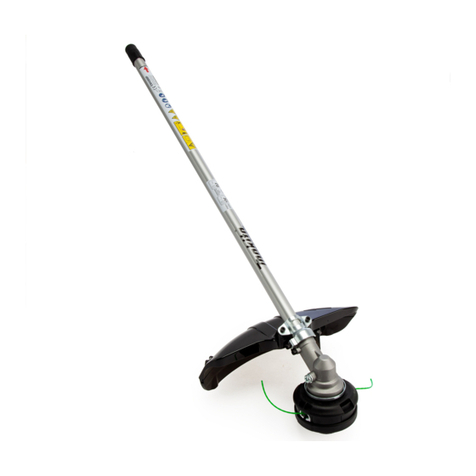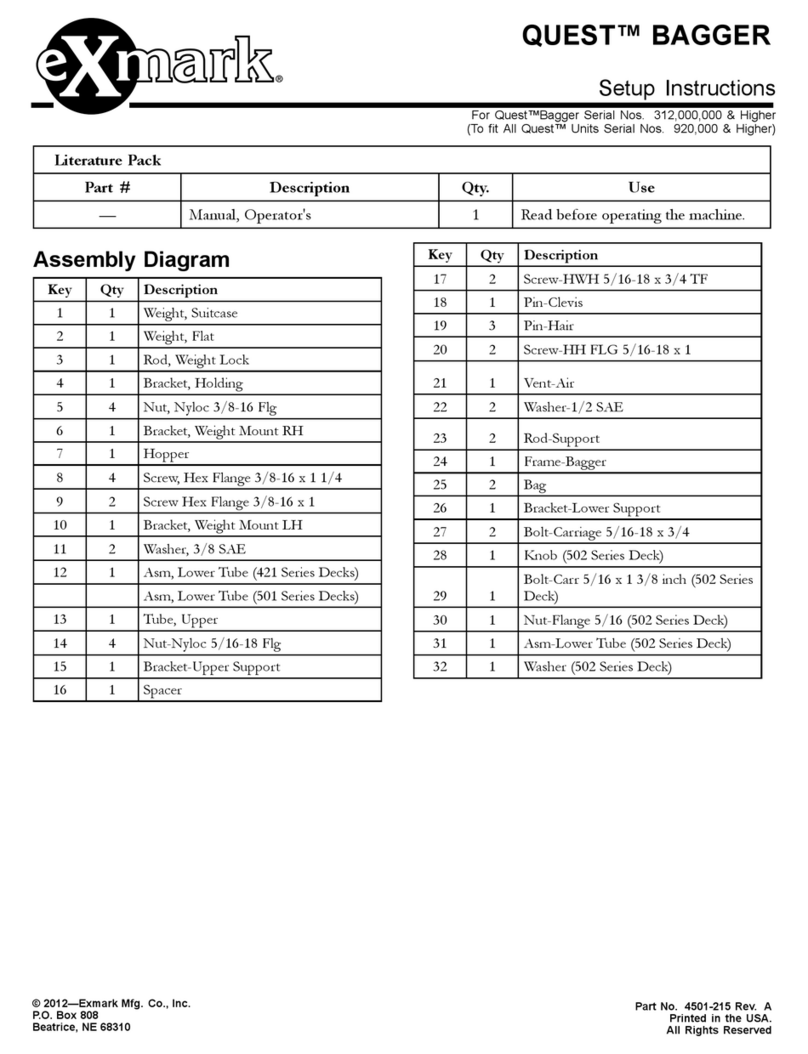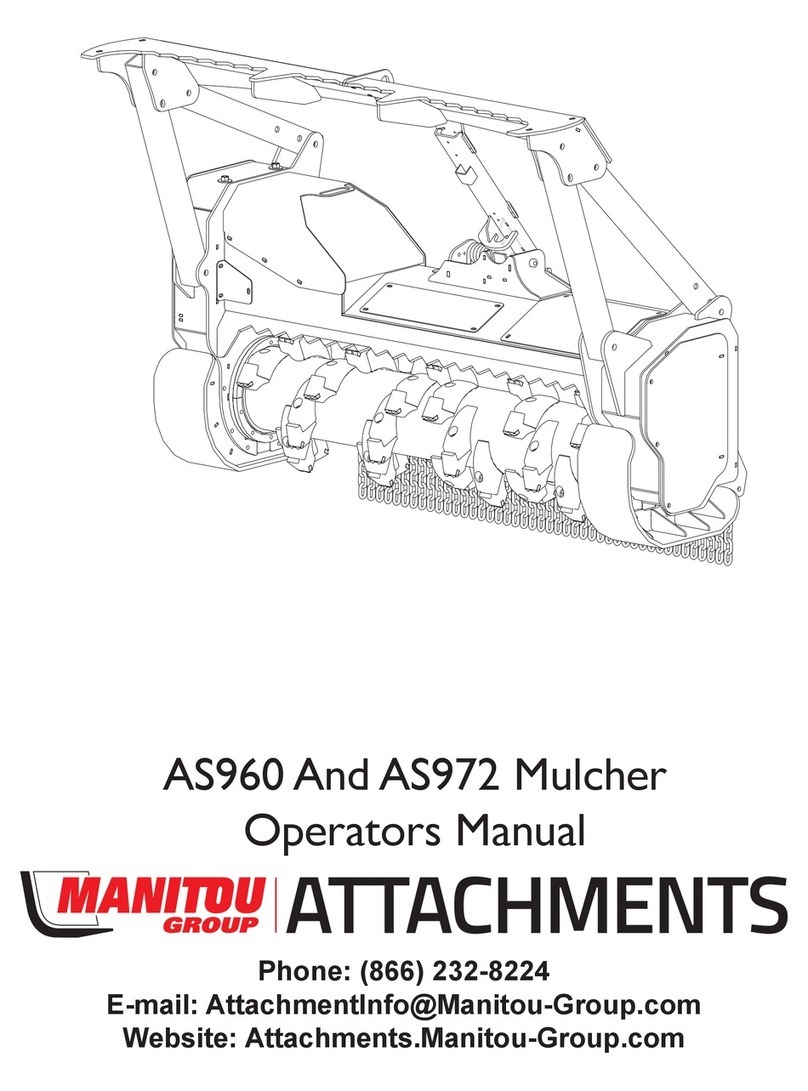Avantco A415691 User manual

Log grab, heavy duty
2021 1
Operator's Manual for Attachment
Log grab, heavy duty
Product number
A415691
English
A448800 2021 1 EN 2020-
www.avanttecno.com

Log grab, heavy duty 2021 1

Log grab, heavy duty 2021 1
CONTENTS
1. FOREWORD ............................................................................................................................................4
Warning symbols used in this manual ............................................................................................................................... 5
2. DESIGNED PURPOSE OF USE.............................................................................................................6
3. SAFETY INSTRUCTIONS FOR USING THE ATTACHMENT........................................................7
3.1 Personal protective equipment........................................................................................................................... 9
3.2 Safe shutdown procedure.................................................................................................................................... 9
4. TECHNICAL SPECIFICATIONS ..........................................................................................................10
4.1 Safety labels and main components of the attachment.................................................................................. 10
5. ATTACHING THE ATTACHMENT ....................................................................................................12
5.1 Connecting and disconnecting hydraulic hoses............................................................................................... 13
6. INSTRUCTIONS FOR USE....................................................................................................................15
6.1 Checks before use................................................................................................................................................. 17
6.2 Operator qualification .......................................................................................................................................... 17
6.3 Operating the Log grab ........................................................................................................................................ 18
6.4 Maximum load........................................................................................................................................................ 19
6.5 Working on uneven ground................................................................................................................................ 20
6.6 Transport position ................................................................................................................................................ 20
6.7 Storing the attachment......................................................................................................................................... 20
7. MAINTENANCE AND SERVICE ..........................................................................................................21
7.1 Inspection of hydraulic components.................................................................................................................. 21
7.2 Cleaning the attachment ...................................................................................................................................... 22
7.3 Lubrication .............................................................................................................................................................. 22
7.4 Inspection of metal structures............................................................................................................................ 22
7.5 End of life disposal................................................................................................................................................. 23
8. WARRANTY TERMS..............................................................................................................................24

4 (26)
1. Foreword
Avant Tecno Oy would like to thank you for your purchase of this attachment for your Avant loader. It has
been designed and manufactured based on years of experience on product development and manufacturing.
By familiarizing yourself with this manual and following the instructions, you ascertain your safety and ensure
the reliable operation and long service life of the equipment. Read the instructions carefully before starting to
use the equipment or performing maintenance.
The purpose of this manual is to help you to:
operate the equipment in a safe and efficient manner
observe and prevent any hazardous situations
keep the equipment intact and ensure a long service life
With these instructions, even an inexperienced user can use the attachment and loader safely. The manual
includes important instructions for experienced AVANT operators as well. Ensure that all persons using the
loader have received proper guidance and familiarised themselves with the manual of the loader, each
attachment that are used, and all safety instructions before using the equipment. Using the equipment for
other purposes or use in any other way than described in this manual is prohibited. Keep this manual at hand
throughout the service life of the equipment. If you sell or transfer the equipment, be sure to hand over this
manual to the new owner. If the manual is lost or damaged, you can request a new one from your Avant
dealer or from the manufacturer.
In addition to the safety instructions included in this manual, you must observe all occupational safety
regulations, local laws, and other regulations concerning the use of the equipment. Particularly the regulations
concerning the use of the equipment on public road areas must be observed. Contact your Avant dealer for
more information about local requirements before you operate the loader on road areas.
Contact your local AVANT dealer for any questions, service, spare parts or about any problems that may
occur with the operation of your machine.
This manual contains the original instructions in English. Due to continuous product development some of the
details shown in this manual may differ from your equipment. Pictures may also depict optional equipment or
features that are not currently available. We reserve the right to change the contents of the manual without
notification. Copyright © 2021 Avant Tecno Oy. All rights reserved.

5 (26)
.
Warning symbols used in this manual
The following warning symbols are used throughout this manual. They indicate factors that must be taken into
account to reduce the risk of personal injury or damage to property:
WARNING SAFETY ALERT SYMBOL
This symbol means: “Warning, be alert! Your safety is involved!”
Carefully read the message that follows, it warns of an immediate hazard
that could cause serious personal injury.
The safety alert symbol by itself and with related safety statement
indicates important safety messages throughout this Manual. It is used to
draw attention to instructions involving your personal safety or the safety
of others. When you see this symbol, be alert, your safety is involved,
carefully read the message that follows, and inform other operators.
DANGER
This signal word indicates a hazardous situation which, if not avoided, will cause
death or serious injury.
WARNING
This signal word indicates a potentially hazardous situation which, if not avoided,
could cause serious injury or death.
CAUTION
This signal word is used when minor injury could result if the instructions are not
followed properly.
This signal word indicates information about the correct operation and maintenance
of the equipment.
Failure to observe the instructions accompanying the symbol can lead to equipment
breakdown or other property damage.

6 (26)
2. Designed purpose of use
The AVANT Log grab HD is an attachment that is suitable for use with AVANT compact loaders that are
shown in Table 1. The Log grab HD is intended for handling timber. The grapple takes a firm grip on the wood
and the lower tines are formed for grabbing bigger tree trunks.
The Log grab HD is equipped with a powerful hydraulic cylinder and can therefore also be used for grabbing
and transporting of bigger stones and similar objects, for example. The log grab is controlled with the controls
of the loader while seated on the driver’s seat of the loader. The upper grapple of the log grab can be lifted or
lowered by using the auxiliary hydraulics of the loader.
The Log grab HD is not intended for other purposes than handling wooden materials, and it must not be
modified, for example, by welding, attaching lifting accessories onto it, or by drilling holes. The log grab is
intended to handle loads that it can normally grab without any additional means.
The Log grab HD is not designed for any other use than what is specified in this manual and must not be used
for any other purposes than what is intended for.
The attachment has been designed to require as little maintenance as possible. The operator can perform
regular maintenance tasks. All repair work can’t be performed by the operator, and demanding repair and
maintenance operations are to be left for professional technicians. All maintenance work must be done using
proper safety equipment. Spare parts must be identical with original specifications, which can be ensured by
using only original spare parts. A separate spare parts catalogue may be available, consult your Avant dealer.
Familiarise yourself with the manual's instructions regarding service and maintenance. Please contact your
AVANT dealer if you have additional questions about the operation or maintenance of the equipment, or if you
require spare parts or maintenance services.
Table 1 - Log grab, heavy duty - Compatibility with Avant loaders
Model
220
225
225LPG
313S
320S
420
423
520
523
R20
525LPG
R28
528
530
630
R35
635
640
735
745
750
755i
760i
850
860i
e5
e6
A415691 - - (•) ••••(•)

7 (26)
3. Safety instructions for using the attachment
Please bear in mind that safety is the result of several factors. The loader-attachment combination is highly
powerful and improper or careless use or maintenance may cause serious personal injury or property
damage. Due to this, all operators must carefully familiarise themselves about correct use and the operator's
manuals of both the loader and the attachment before starting operation. Do not use the attachment if you
have not completely familiarised yourself with its operation and the related hazards.
DANGER
Misuse, careless use, or using an attachment that is in poor condition may
cause risk of serious injuries.
Familiarise yourself with the controls of the loader,
correct coupling proc
edure, and the correct way to operate the attachment at a safe
area. Study especially how to stop the equipment in a safe manner. Read all safety
precautions carefully.
Read all safety instructions carefully before handling the attachment
WARNING
When attaching an attachment to the loader, ensure that the locking pins of the
loader's quick attach plate are in the lower position and that they have locked
the attachment to the loader. Never lift or move an unlocked attachment.
This attachment is designe
d to be used by one operator at a time. Do not let others
near the danger area of the equipment when it is in use.
Always transport the attachment as low as possible to keep the centre of gravity low,
and keep the telescopic boom retracted during driving.
Risk of crushing - Never go or allow anyone else to go under the loader boom
or attachment. The stability of the loader may change when leaving the driver’s seat,
leading to tipping over of the machine. Always remember that the boom may lower
unexpected
ly due to loss of stability, mechanical fault, or if another person operates
the controls of the loader, leading to crushing hazard. The loader is not intended to
be left to keep a load elevated for longer periods. Lower the attachment firmly on the
ground
before leaving the driver's seat and never allow anyone to be under the boom
or attachment.
Sudden movements can cause the loader to tip over - Operate the controls of
the loader in a slow and calm manner.
Be careful when lifting load to high level or
lifting load from high. Avoid sudden changes in speed or direction to maintain
balance of the loader especially when handling heavy loads. Drive slowly and
carefully especially on inclined terrain or slippery surfaces.
Risk of tipping over - Keep loads close to ground while driving. Carrying heavy
loads can shift the centre of gravity of the loader and lead to tipping over of the
loader. For the best stability always transport loads as low and close to the loader as
possible, with the telescopic boom com
pletely retracted, to keep the centre of gravity
low.
Do not connect any lifting equipment to the log grab.
Keep the loader articulation in straight position when handling heavy loads. When
turning the articulation, the loader may tilt forward.
Observe maximum load indicated in the operator’s manual of the loader. Be
especially careful when the load sensor indicator is activated, if your loader is fitted
with a load sensor system.
Make sure that the surface can bear the total load. Also follow the correct tyre
pressure settings.

8 (26)
WARNING
Tipping over - Crushing hazard - Do not try to move an unattached attachment by
pushing or dragging it, instead, always handle it with the loader.
Ensure that an unattached attachment is supported properly and can't accidentally
move or tip over.
Pay attention to the surroundings and any other persons and machines moving in the
vicinity. Other persons must keep safety distance of 5 meters. Pay attention to the
contours of the terrain and other hazards, such as bra
nches and trees that can reach
to the driver's area, loose rocks, and slippery surfaces.
Never use the attachment to lift or to transport persons or as any kind of work
platform even temporarily.
Make sure to use only an attachment that is in good condition. Check the attachment
thoroughly in regular intervals. Do not modify the attachment in a manner that would
affect its safety. It is prohibited to drill holes on the attachment, and welding or other
means of fixing hooks or other objects on the attachment is strictly prohibited.
Use the attachment only for its intended purpose. Other use may create unnecessary
safety risks, and the equipment may get damaged.
Make sure that the loader is equipped with necessary safety components, and that
they a
re in working condition. Seat belt must be used. If there are specific hazards
related to the operating area, use appropriate safety equipment.
Also read the safety instructions and correct use of the loader from the operator's
manual of the loader.
. ..
DANGER
Risk of crushing -
Going under the loader boom or an attachment can cause
serious injury or death.
Never go under the loader boom and prevent others from
getting near lifted boom or attachment. Going under a raised attachment or loader bo
om
is dangerous, as the boom may lower due to loss of stability, mechanical fault or when
other person operates the controls of the loader. Lower the attachment firmly on the
ground to a safe position before leaving the driver’s seat.
Keep in mind that the
loader boom can be lowered or tilted even if the engine has been
shut down (crushing hazard). The loader is not intended to be left to keep a load elevated
for longer periods. Always lower the attachment to a safe position before leaving the
driver's seat.
.

9 (26)
3.1 Personal protective equipment
Remember to wear proper personal protective equipment:
The noise level at the driver's seat may exceed 85 dB(A) depending on loader
model and operating cycle. Extended exposure to loud noise can cause
hearing impairment. Wear hearing protection while working with the loader.
Wear protective gloves.
Wear safety boots whenever working with the loader.
Wear safety glasses e.g. when handling hydraulic components.
. ..
3.2 Safe shutdown procedure
Safe position of the attachment, before going near the loader boom:
WARNING
Always set the attachment to a safe position before going near the attachment.
Safe position will prevent unintentional movements of the attachment and the loader
boom. Note that the attac
hment can move even if the engine of the loader is turned off.
Safe stopping procedure:
Lower the boom completely down and lower the attachment flat on the ground.
Shut down the loader engine and lock the parking brake.
Prevent starting of the machine, remove ignition key.

10 (26)
4. Technical specifications
Table 2 - Log grab, heavy duty - Specifications
Product number A415691
Width: 845 mm
Height: 1000 mm
Grapple opening: 926 mm
Empty weight: 180 kg
Maximum allowed load: 1800 kg / As restricted by the loader model,
see operator’s manual of the loader
Recommended input of hydraulic
energy: 10 - 25 l/min, 22,5 MPa (225 bar)
Maximum input of hydraulic energy: 30 l/min, 22,5 MPa (225 bar)
Suitable Avant loaders: See Table 1
4.1 Safety labels and main components of the attachment
Listed below are the labels and markings on the attachment. They must be visible and readable on the
equipment. Replace any unclear or missing label. New labels are available via your retailer or contact
information provided on the cover.
WARNING
Make sure all warning decals are readable.
The warning labels contain important
safety information and they help to identify and remember the hazards related to the
equipment. Replace damaged or missing warning labels with new ones.
Attachment identification plate
A442595
A46771 A46772 A46803
To apply a new label: Clean the surface thoroughly to remove all grease. Allow it to dry completely. Peel off
the protective film of the label and press firmly to apply. Take care not to touch the glue of the label.

11 (26)
Table 3 - Decal locations and warning messages
Decal Warning message
1 A46771 Misuse hazard -
Read instructions before
use.
2 A46772 Crushing hazard -
Do not go under a
raised attachment; stay away from raised
equipment.
3
A46803
Pinching and cutting hazard, keep clear
of moving parts, do not leave the
equipment running. Operate the
attachment only from the driver’s seat.
4
A442595
Attachment identification plate
. ..
Table 4 - Log grab, heavy duty - Main components
1 Frame with Avant quick coupling brackets
2 Grapple
3 Tilting cylinder
4 Multiconnector holder
5 Multiconnector

12 (26)
5. Attaching the attachment
Attaching the attachment to the loader is quick and easy, but it must be done carefully. The attachment is
mounted to the loader boom by using the quick attach plate on the loader boom and the counterpart on the
attachment.
If the attachment is not locked to the loader, it may detach from the loader and cause a hazardous situation.
The loader must not be driven and the boom must never be lifted when the attachment has not been locked.
To prevent hazardous situations, always follow the coupling procedure shown below. Also remember the
safety instructions shown in this manual. The attachment is mounted to the loader as follows:
WARNING
Crushing risk - Make sure that an unlocked attachment will not move or fall over.
Do not stay in the area between the attachment and the loader. Mount the attachment
only on level surface.
Never move or lift an attachment that has not been locked.
Avant quick coupling system:
Step 1:
Lift the quick attach plate locking pins up and turn them backwards into the slot
so that they are locked in the upper position.
If your loader is equipped with a hydraulic a
ttachment locking system, see
additional instructions about the use of the locking system from the relevant
manuals.
Make sure that the hydraulic hoses are positioned so that they will not get in
between the coupling plate of the loader and the attachment,
and that they will
not get squeezed or chafed against sharp edges.
Step 2:
Turn the quick attach plate hydraulically to an obliquely forward position.
Drive the loader onto the attachment. If your loader is equipped with a
telescopic boom, you can utilise this.
Align the upper pins of the loader’s quick coupling plate so that they are under
the corresponding brackets of the attachment.
Step 3:
Lift the boom slightly –
pull the boom control lever backward to raise the
attachment off the ground.
Turn the boom control lever left to turn the bottom section of the quick attach
plate onto the attachment.
Lock the locking pins manually or lock the hydraulic locking.
Always check the locking of both locking pins.

13 (26)
WARNING
Risk of crushing - Avoid tipping over the attachment.
Excessive tilting or lifting of an
unlocked attachment increases the risk of tipping the attachment over. Do not use the
automatic locking of the locking pins when the attachment is lifted more than one meter
from the ground. I
f the locking pins do not return to the normal position when tilting, do
not tilt or raise the attachment any more. Lower the attachment on the ground and
secure the locking manually.
WARNING
Risk of falling objects -
Prevent dropping of
attachment.
An attachment that has not been completely locked to the
loader may fall on the boom or towards the operator, or
fall under the loader during driving, causing loss of
control of the loader. Never move or lift an attachment
that has not been locked. Before
moving or lifting the
attachment, make sure that the locking pins are in the
lower position and come through the fasteners on the
attachment on both sides.
WARNING
Make sure the loader is compatible with the attachment. Stability of the loader,
possible overload of the attachment, and compatibility of loader control systems must be
ensured in addition to mechanical compatibility of the attachment. If you use the
attachment with a loader that is not fit to be used with the attachment model you have,
risks include tipping over, damage to attachment due to overload, and risks related to
uncontrolled motion of attachment and its parts. If your loader is not listed in Table 1 on
page 6, ask your Avant dealer before using this attachment.
5.1 Connecting and disconnecting hydraulic hoses
On Avant loaders the hydraulic hoses are connected using the multi connector system. If you have an Avant
300-700 series loader with the conventional quick couplers and wish to change to the multi connector system,
contact your Avant dealer or service point for instructions or installation services.
WARNING
Risk of movement of the attachment and ejection of hydraulic oil -
Never connect
or disconnect quick couplings or other hydraulic components
while the control
lever of the auxiliary hydraulics control lever is locked on or if the system is
pressurized.
Connecting or disconnecting the hydraulic couplings while the system is
pressurized may lead to unintended movements of the attachment, or ejection of high-
pressure fluid, which can cause serious injuries or burns. Follow safe stopping procedure
before disconnecting hydraulics.

14 (26)
Keep all fittings as clean as possible; use the protective caps on both the attachment and
the loader. Dirt, ice,
etc. may make using the fittings significantly more difficult. Never
leave the hoses hanging on the ground; place the couplings onto the holder on the
attachment.
Connecting the multiconnector system:
1.
Align the pins of the attachment connector with corresponding
holes of the loader connector. The multiconnector will not connect
if the attachment connector is upside down.
2.
Connect and lock the multiconnector by turning the lever towards
the loader.
The lever should move easily all the way to its locking position. If the lever does not slide smoothly, check the
alignment and position of the connector and clean the connectors. Also shut down the loader and release the
residual hydraulic pressure.
To disconnect the multiconnector system:
Before dis
connecting put the attachment down on a solid and even
surface.
1. Switch off the auxiliary hydraulics of the loader.
2.
While pushing unlock button, turn the lever to disconnect the
connector.
3.
After ending operation put the multiconnector on its holder on the
attachment.
Disconnecting hydraulic hoses:
Before disconnecting the fittings, lower the attachment to safe position on solid and level surface. Turn the
control lever of the auxiliary hydraulics to its neutral position.
When uncoupling the attachmen
t, always disconnect the hydraulic couplings before
unlocking the quick coupling plate, to prevent hose damage and any oil spills. Reinstall
the protective caps on the fittings to prevent impurities from entering the hydraulic
system.
Releasing residual hydraulic pressure:
In case residual pressure is left in the hydraulic system of the attachment, it is often possible to disconnect the
hydraulic couplings, but it may be difficult to connect them the next time. If the fittings will not connect, the
residual pressure must be released by turning the auxiliary hydraulics control lever of the loader, when the
engine is turned off. To make sure that there will not be residual pressure in the hydraulic system of the
attachment, shut down the loader engine and move the auxiliary hydraulics control lever of the loader back
and forth before disconnecting the couplings.

15 (26)
6. Instructions for use
Check the attachment and the operating environment once more before starting to work, and that all obstacles
have been removed from the operating area. Quick inspection of the equipment and the operating area before
use are parts of ensuring safety and the best performance of the equipment.
WARNING
Risk of tipping over - Avoid overload.
Loader can tip over
when handling too h
eavy loads, or because of dynamic
movements caused by driving with and handling of a heavy
load. Do not extend the telescopic boom when the load
approaches the lifting capacity of the loader, or when the
loader boom is in horizontal position. When you noti
ce that
the rear wheels of the loader are about to lift from the ground,
or if the load indicator of the loader (if fitted) signals:
Lower the load calmly and retract the telescopic boom
Avoid sudden changes in speed or direction whenever load is lifted
Use additional counterweights as needed
. ..
WARNING
Risk of crushing -
Ensure that the parking brake of the
loader is engaged when working near the attachment.
Use additional blocks if needed. Whenever possible, lower
the attachment firmly on the ground.
. ..
WARNING
Risk of crushing -
The sharp tines of the attachment and
its grapple can cause serious injuries.
Make sure that
there are no other persons at the operating area and keep a
safe distance to persons or farm animals. Lower
the grapple
before driving with the loader. Stop the loader following the
safe stopping procedure before going near the attachment.

16 (26)
WARNING
Risk of falling from height and crushing under bucket or
loader - Never use a bucket as a lifting platfor
m or to
carry people.
Never use the loader or its attachments to lift
persons or as any kind of work platform even temporarily.
Never climb on the attachment.
Always lower the bucket on the ground before leaving the
driver's seat. The loader is not intende
d to hold loads lifted for
longer periods of time.
WARNING
Risk of tipping over -
Avoid overload and keep heavy load close to the loader. Keep
loads close to the ground whenever driving, especially during turns and uneven
terrain. Pay attention t
hat a heavy load or long distance between the loader and the
centre of gravity of the load will affect the balance and handling of the loader. The use of
additional counterweights is recommended especially when operating smaller loader
models. With heavy l
oads, the telescopic boom must be kept retracted while moving with
the loader. Always wear seat belt.
WARNING
Risk of crushing - Abrupt movements can cause loss of stability.
Movements, such
as stopping, turning, or lowering the boom abruptly, can ca
use loss of stability. Always
drive slowly and operate the controls of the loader very carefully when handling heavy
loads.

17 (26)
6.1 Checks before use
Check the general condition of the attachment and the loader, and check for possible hydraulic oil
leaks. The attachment must not be used, if there is a fault in the hydraulic system of the loader or the
attachment. Refer to Chapter 7 for instructions on maintenance and inspections.
Before first use, check the hydraulic fittings and all possible movements of the attachment. Move the
Log grab in all possible directions to examine that all the hydraulic hoses have enough space for the
boom operation.
Remove all obstacles from the operating area and prepare lifted logs beforehand. Remember correct
working methods and avoid leaving the driver’s seat unnecessarily.
Ensure that the ground surface is level and solid enough for safe operation.
Drive carefully on uneven terrain and note the effect of heavy load at the front of the loader to the
stability and handling of the loader.
Ensure that bystanders are at a safe distance when operating the equipment. Do not let anyone to
enter danger area of the boom or to stay directly in front of the loader. Also make sure that it is safe to
reverse with the loader. Never assume that bystanders will remain where you last saw them;
especially children are often attracted to the moving equipment.
Check the general condition of the attachment and the loader, and check for possible hydraulic oil
leaks. Do the daily checks of the loader, see the operator's manual of the loader. The attachment must
not be used, if there is a fault in the hydraulic system of the loader or the attachment. Refer to Chapter
7 for maintenance instructions.
Operate the attachment and the controls of the loader only when seated on the driver’s seat. Ensure
that the loader and the attachment are used in a safe manner and as intended. Do not allow children
to operate the equipment.
Remember correct working methods and avoid leaving the driver’s seat unnecessarily.
6.2 Operator qualification
Anyone who intends to use the attachment must:
Know the intended use of the attachment.
Know how to use the loader safely in different operating conditions.
Read and always follow the instructions concerning the use of the attachment in this operator's
manual.
Have this manual and the operator's manual of the loader available.
Ensure that the loader and the attachment are used in a safe manner and as intended.
Never allow children to operate the equipment.
Never operate the loader or attachments while under the influence of alcohol, drugs, medication that
may impair judgement or cause drowsiness, or if not otherwise medically fit to operate the equipment.
Complete any possible mandatory training required by the employer before use.
.

18 (26)
6.3 Operating the Log grab
WARNING
Avoid sudden loss of stability - Never drag loads from e.g. a shelf.
If the load that
you want to lift from height is too heavy, the loader can tip forward when reversing with
the loader. Never reverse and drag with the lo
ader before making sure that the loader
can handle the load that is being lifted.
WARNING
Risk of serious personal injuries -
Ensure that there are no other persons near the
operating area. Do not allow others closer than 5 metres form the grab, to
the boom
danger area, or directly in front or back of the loader. Move carefully and calmly near
persons or farm animals. Also make sure that it is safe to reverse with the loader.
Keep in mind the maximum allowed
load of the log grab and the
maximum l
oad handling capacity of
the loader. Use the maximum load
indicated in the diagram of the
operator’s manual of the loader as
a guideline.
Remember that the actual load
carrying capacity varies according
to operating conditions, especially
unevenness of ope
rating area has
a great effect. Be especially careful
when the load sensor indicator is
activated. Also, make sure that the
ground surface is firm and follow
recommended tire pressures.
Before using the Log grab for the first time, check that the h
ydraulic hoses are
positioned so, that you can move the loader boom and the grapple to all positions.

19 (26)
Controlling the grapple:
Move the auxiliary
hydraulics control lever
towards its locking
position (or use the
electric buttons of the
optional electr
ic joystick)
to close the grapple.
The lever should not be
left to the locking
position.
Move the lever away
from the locking position
to open the grapple.
6.4 Maximum load
When transporting load with the
Log grab HD, make sure that the
l
oad is well balanced and stays
firmly. The load must be
transported calmly as low and close
to the loader as possible, and the
swinging of the load must be
avoided.
Maximum allowed load for the
attachment is 1800 kg. Also refer to
the operator's manual of
the loader
for the working load limit of the
loader in different operating
conditions.

20 (26)
6.5 Working on uneven ground
Extra caution is needed when using the equipment on inclined terrains and slopes. Drive slowly especially on
inclined, uneven, or slippery surfaces, and avoid sudden changes in speed or direction. Operate the controls
of the loader with careful and smooth movements. Watch out for ditches, holes on the ground, and other
obstacles, as hitting an obstacle may cause the loader to tip over.
Maximum lifting capacity can not be achieved on inclined terrain. On horizontally tilted terrain the load must
not be lifted high. The loader frame articulation should be kept straight when lifting heavy loads; turning the
load during lifting operation will affect the stability of the loader and may lead to overturning of the machine.
6.6 Transport position
Keep the loader stable. Always transport the
attachment as low and close to the ground as
possible. Keep the telescopic boom retracted during
drive.
6.7 Storing the attachment
Uncouple and store the attachment on
level ground. The best way to store the
attachment is a place where it is protected
from direct sunlight, rain, and extreme
temperatures.
Avoid leaving the attachment laying
directly on the groun
d. Place it on
blocks of wood or on a pallet, for
example.
Place the multiconnector on to its
holder as indicated with an arrow in the
adjacent figure. Never leave the
hydraulic connector on the ground.
Make sure that the attachment is
secured against all
movements during
storage.
Never climb on the attachment.
For longer storage periods touch up the paint where needed, grease the lubrication points and oil the visible
parts of the hydraulic cylinder shafts to prevent rust damage.
Table of contents
Other Avantco Lawn And Garden Equipment manuals
Popular Lawn And Garden Equipment manuals by other brands
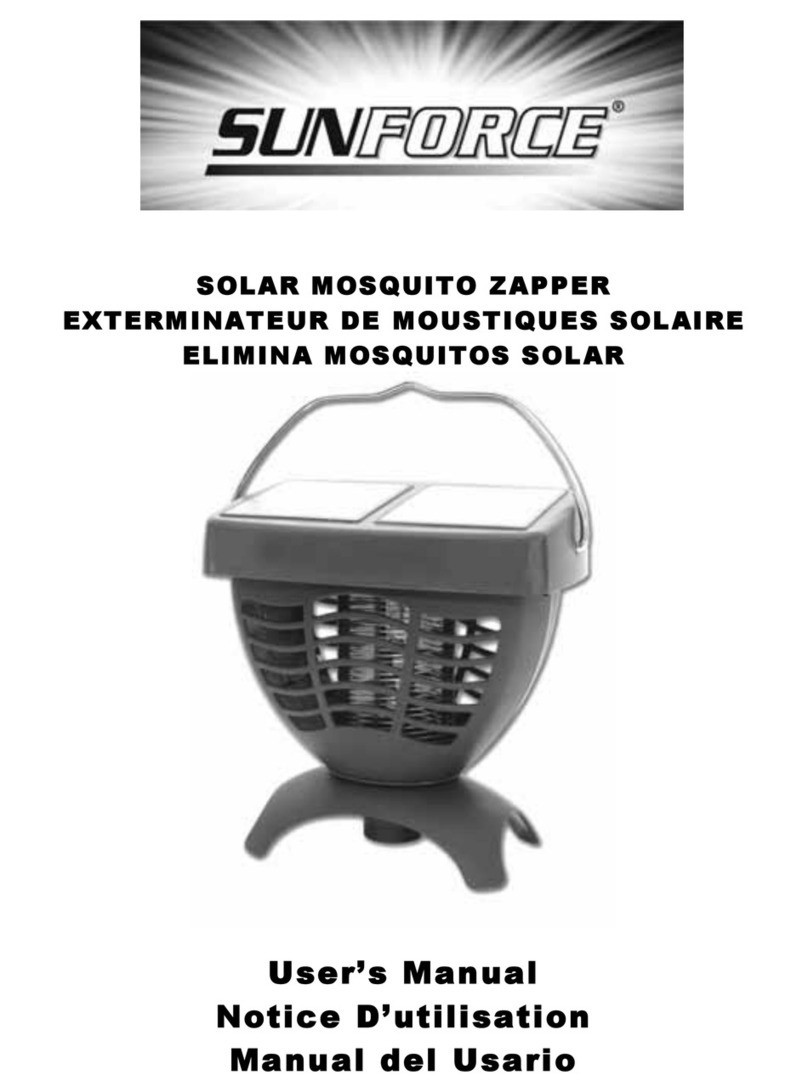
Sunforce
Sunforce SOLAR user manual
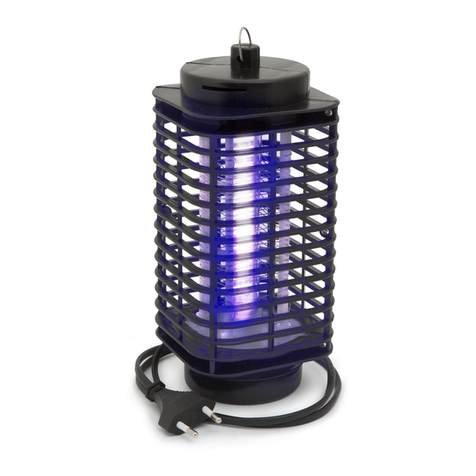
GARDEN OF EDEN
GARDEN OF EDEN 55627 user manual
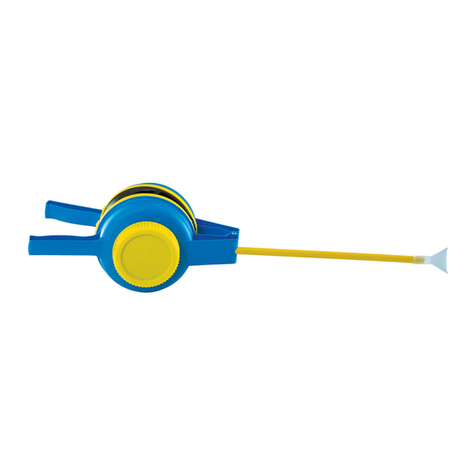
Goizper Group
Goizper Group MATABI POLMINOR instruction manual
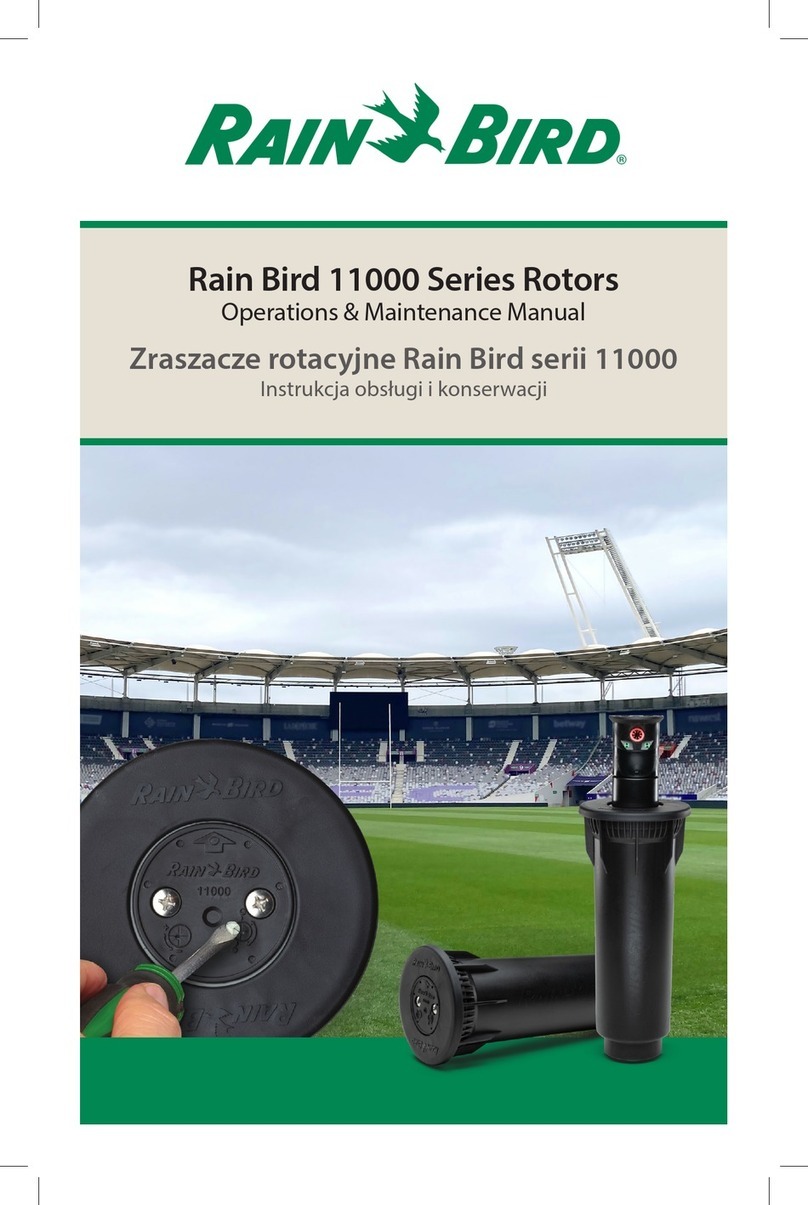
Rain Bird
Rain Bird 11000 Series Operation & maintenance manual
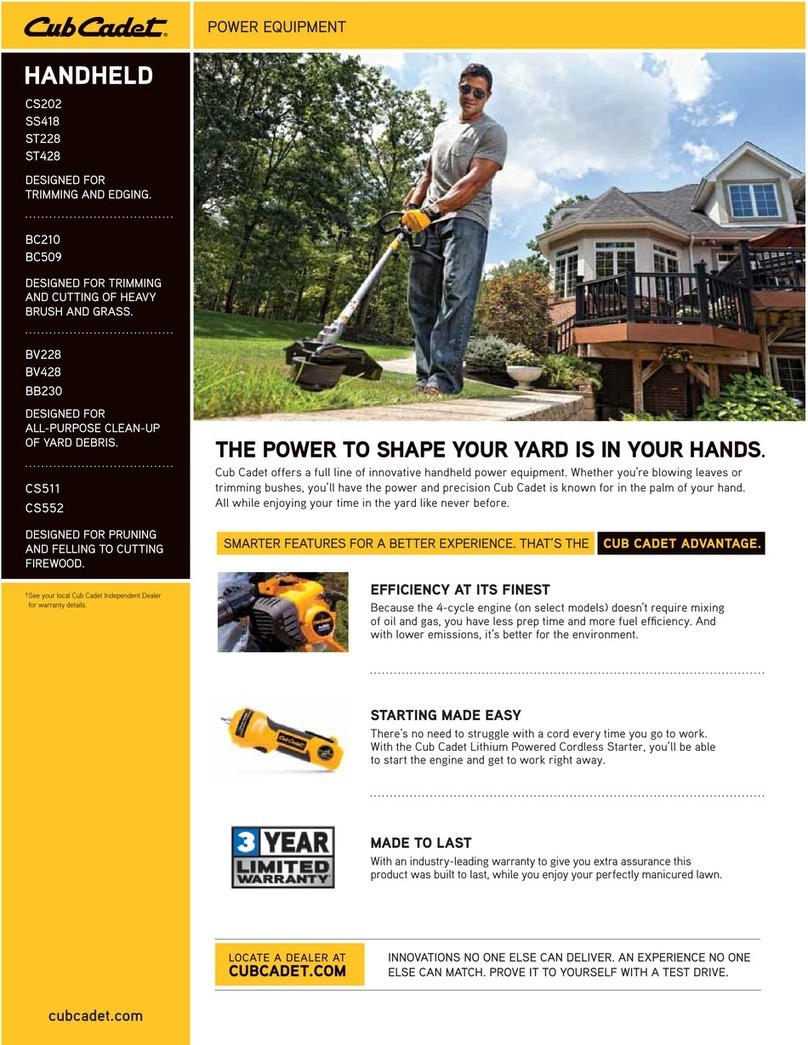
Cub Cadet
Cub Cadet BB 230 brochure
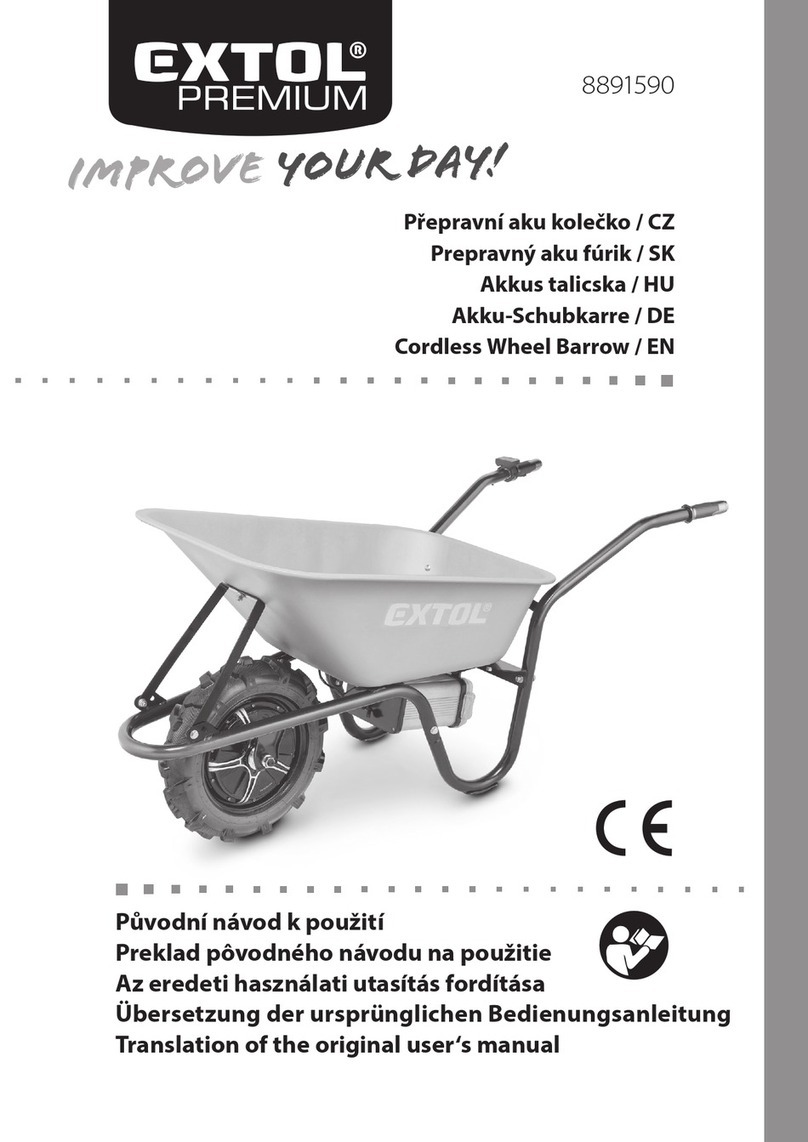
EXTOL PREMIUM
EXTOL PREMIUM 8891590 Translation of the original user manual
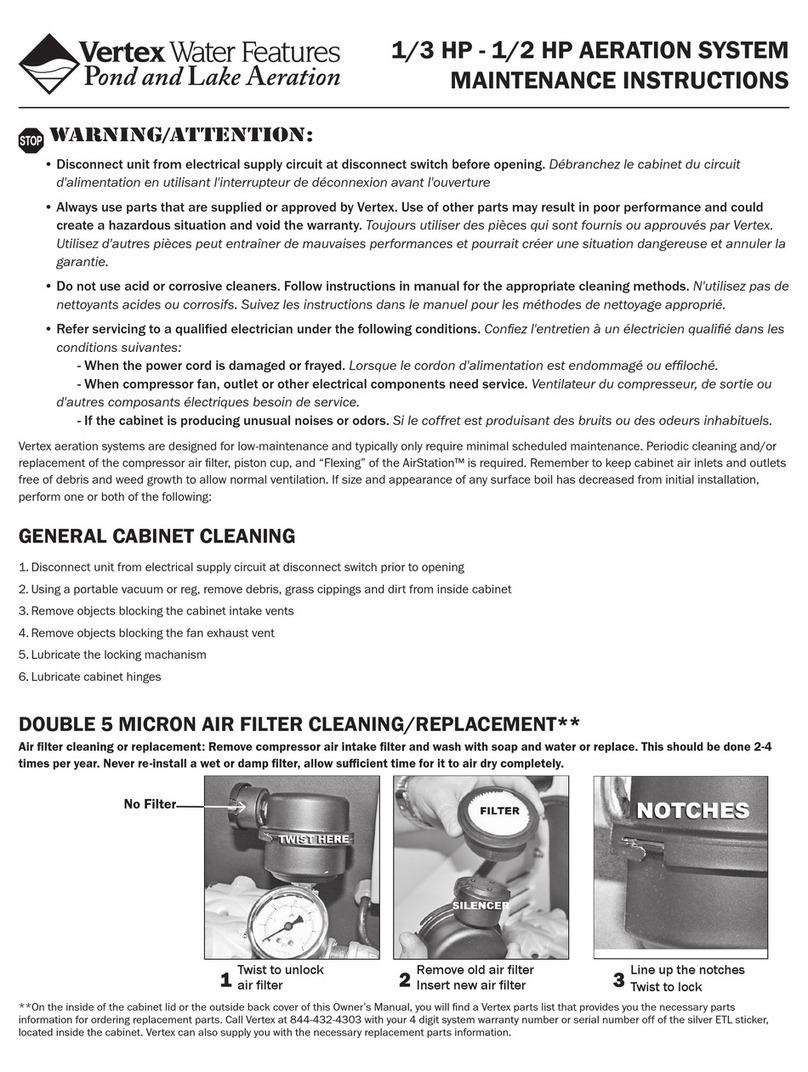
Vertex
Vertex 1/3 HP Maintenance instructions
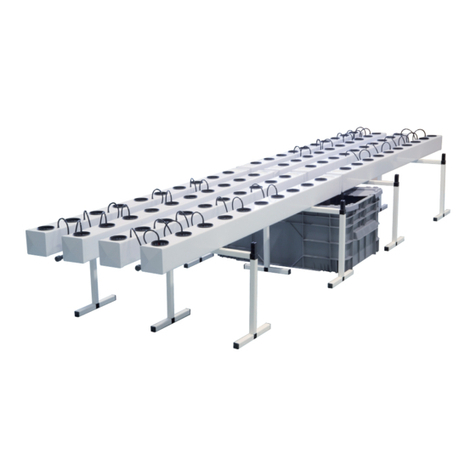
GHE
GHE AeroFlo 80 manual
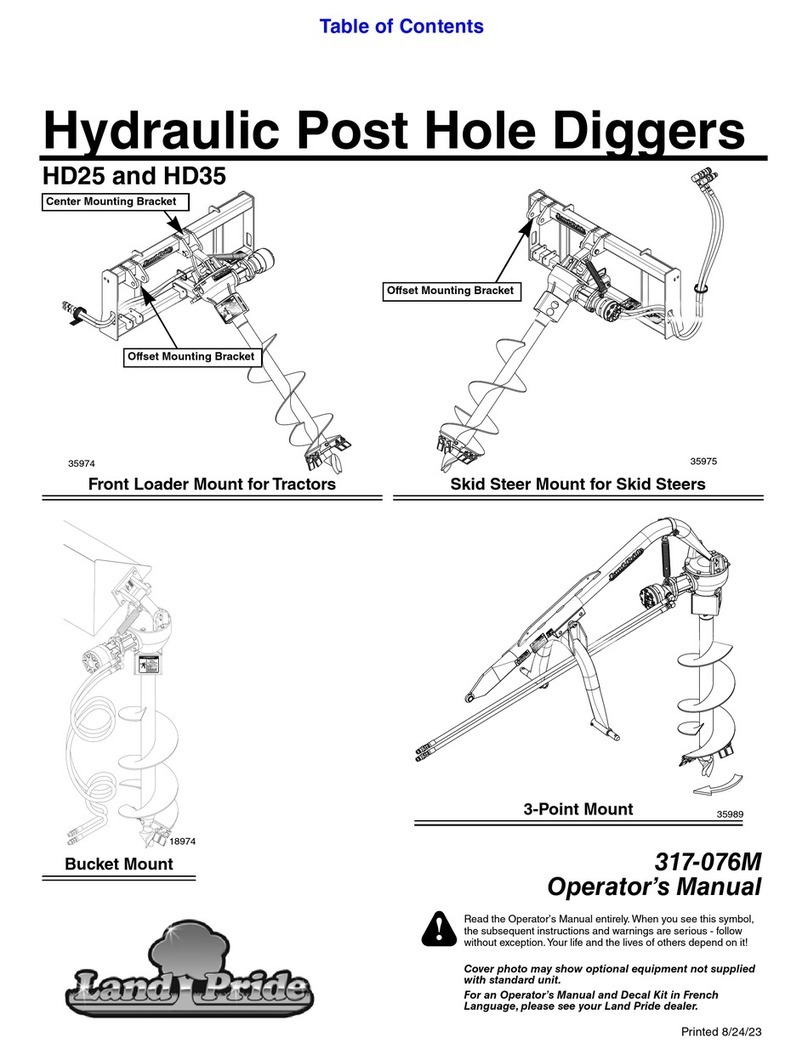
Land Pride
Land Pride Post Hole Diggers HD25 Operator's manual
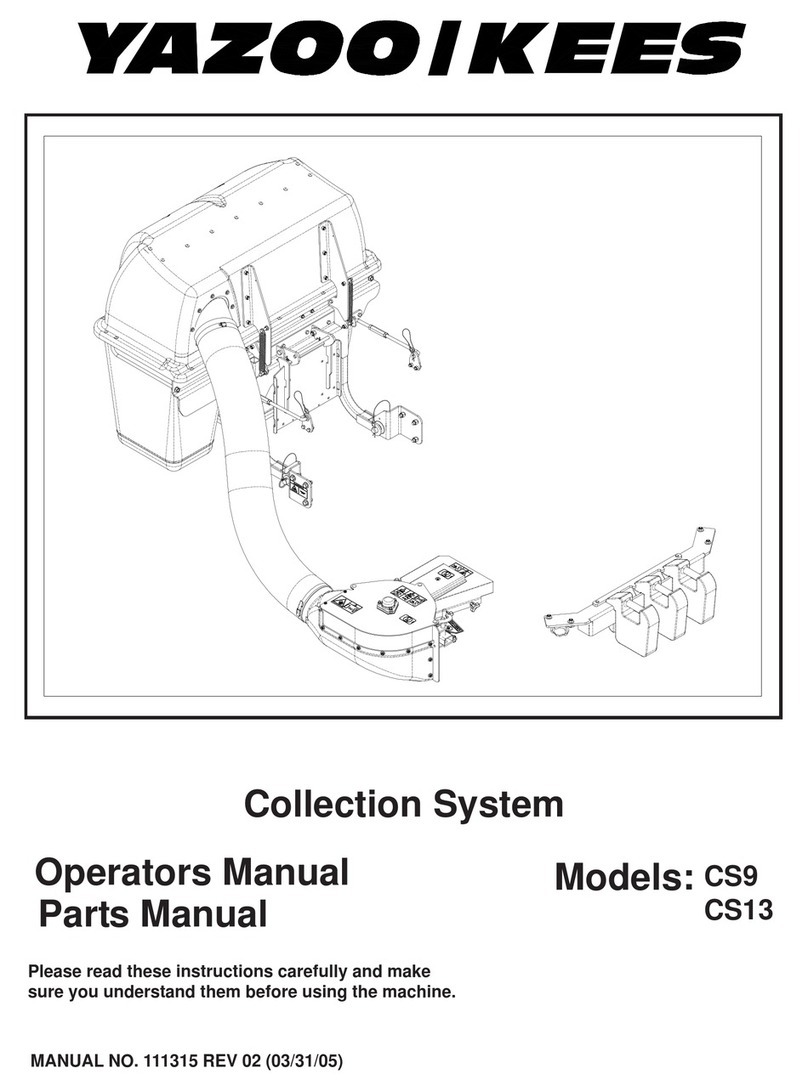
Yazoo/Kees
Yazoo/Kees Z9 Commercial Collection System Z9A Operator's & parts manual

Premier designs
Premier designs WindGarden 26829 Assembly instructions
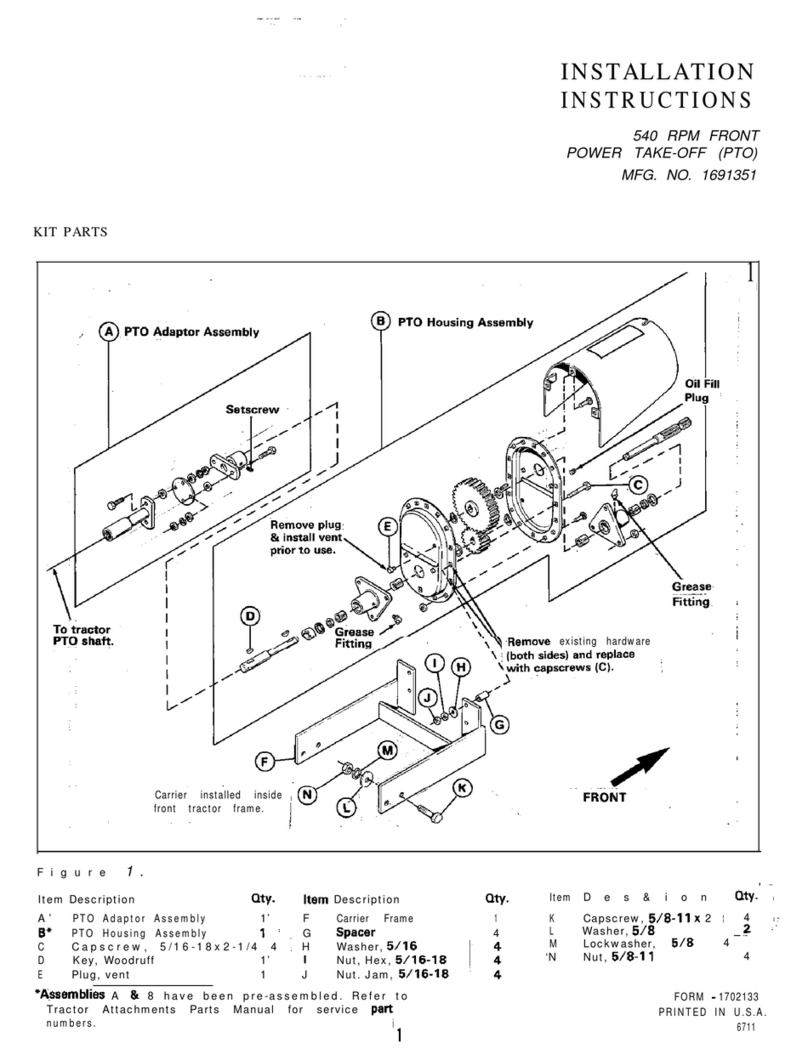
Snapper
Snapper 1691351 installation instructions
